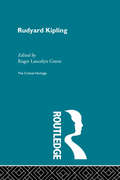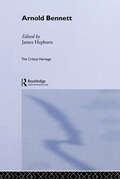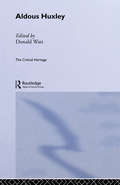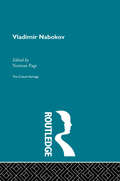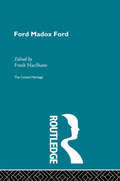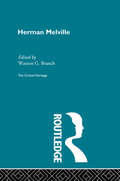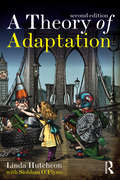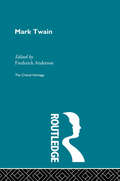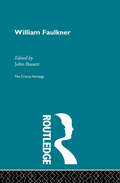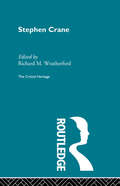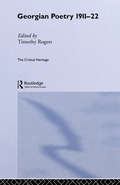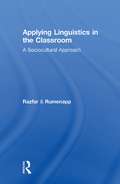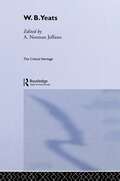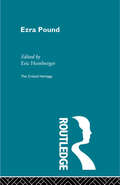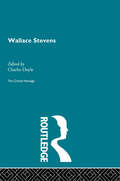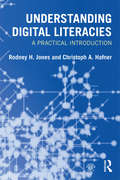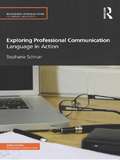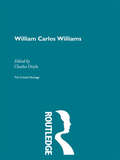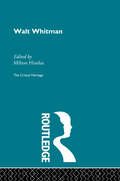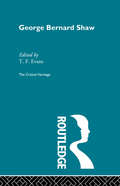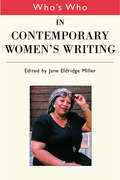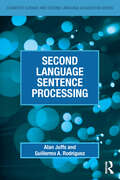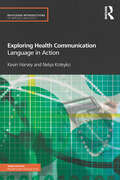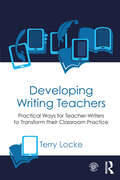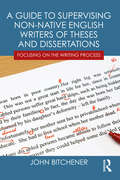- Table View
- List View
Rudyard Kipling (Collected Critical Heritage Ser. #Series 2)
by Roger Lancelyn GreenThis set comprises 40 volumes covering 19th and 20th century European and American authors. These volumes will be available as a complete set, mini boxed sets (by theme) or as individual volumes. This second set compliments the first 68 volume set of Critical Heritage published by Routledge in October 1995.
Arnold Bennett
by James HepburnThis set comprises fory volumes covering nineteenth and twentieth century European and American authors. These volumes will be available as a complete set, mini boxed sets (by theme) or as individual volumes. This second set compliments the first sixty-eight volume set of Critical Heritage published by Routledge in October 1995.
Aldous Huxley
by Donald WattThis set comprises forty volumes covering nineteenth and twentieth century European and American authors. These volumes will be available as a complete set, mini boxed sets (by theme) or as individual volumes. This second set compliments the first sixty-eight volume set of Critical Heritage published by Routledge in October 1995.
Vladimir Nabokov
by Norman PageThis set comprises of 40 volumes covering nineteenth and twentieth century European and American authors. These volumes will be available as a complete set, mini boxed sets (by theme) or as individual volumes. This second set compliments the first 68 volume set of Critical Heritage published by Routledge in October 1995.
Ford Maddox Ford: The Critical Heritage (Critical Heritage Ser.)
by Frank MacShaneThis set comprises 40 volumes covering nineteenth and twentieth century European and American authors. These volumes will be available as a complete set, mini boxed sets (by theme) or as individual volumes. This second set compliments the first 68 volume set of Critical Heritage published by Routledge in October 1995.
Herman Melville (Critical Heritage Ser.)
by Watson G. BranchThis set comprises 40 volumes covering 19th and 20th century European and American authors. These volumes will be available as a complete set, mini boxed sets (by theme) or as individual volumes. This second set complements the first 68 volume set of Critical Heritage published by Routledge in October 1995.
A Theory of Adaptation
by Linda HutcheonA Theory of Adaptation explores the continuous development of creative adaptation, and argues that the practice of adapting is central to the story-telling imagination. Linda Hutcheon develops a theory of adaptation through a range of media, from film and opera, to video games, pop music and theme parks, analysing the breadth, scope and creative possibilities within each. This new edition is supplemented by a new preface from the author, discussing both new adaptive forms/platforms and recent critical developments in the study of adaptation.? It also features an illuminating new epilogue from Siobhan O’Flynn, focusing on adaptation in the context of digital media. She considers the impact of transmedia practices and properties on the form and practice of adaptation, as well as studying the extension of game narrative across media platforms, fan-based adaptation (from Twitter and Facebook to home movies), and the adaptation of books to digital formats. A Theory of Adaptation is the ideal guide to this ever evolving field of study and is essential reading for anyone interested in adaptation in the context of literary and media studies.
Mark Twain: The Critical Heritage (Mark Twain Papers #7)
by Frederick AndersonThis set comprises 40 volumes covering 19th and 20th century European and American authors. These volumes will be available as a complete set, mini boxed sets (by theme) or as individual volumes. This second set compliments the first 68 volume set of Critical Heritage published by Routledge in October 1995.
William Faulkner: An Annotated Bibliography Of Criticism Since 1988
by John BassettThis set comprises of 40 volumes covering nineteenth and twentieth century European and American authors. These volumes will be available as a complete set, mini boxed sets (by theme) or as individual volumes. This second set compliments the first 68 volume set of Critical Heritage published by Routledge in October 1995.
Stephen Crane
by Richard M. WeatherfordThis set comprises 40 volumes covering 19th and 20th century European and American authors. These volumes will be available as a complete set, mini boxed sets (by theme) or as individual volumes. This second set compliments the first 68 volume set of Critical Heritage published by Routledge in October 1995.
Georgian Poetry 1911-22
by Timothy RogersThis set comprises 40 volumes covering 19th and 20th century European and American authors. These volumes will be available as a complete set, mini boxed sets (by theme) or as individual volumes. This second set complements the first 68 volume set of Critical Heritage published by Routledge in October 1995.
Applying Linguistics in the Classroom: A Sociocultural Approach
by Aria Razfar Joseph C. RumenappMaking linguistics accessible and relevant to all teachers, this text looks at language issues in the classroom through an applied sociocultural perspective focused on how language functions in society and in schools—how it is used, for what purposes, and how teachers can understand their students’ language practices. While touching on the key structural aspects of language (phonetics, phonology, morphology, and syntax), it does not simply give an overview, but rather provides a way to study and talk about language. Each chapter includes practical steps and suggests tools for applying different kinds of linguistic knowledge in classrooms. The activities and exercises are adaptable to elementary or high school settings. Many examples focus on the intersection of math, science, and language. Teacher case studies show how real teachers have used these concepts to inform teaching practices. Given the increasing use of multimedia resources in today’s schools, multiple mediums are integrated to engage educators in learning about language. The Companion Website provides a multitude of relevant resources that illustrate the diversity of language functions and debates about language in society.
W.B. Yeats: The Critical Heritage (The\critical Heritage Ser.)
by A. Norman JeffaresThis set comprises of 40 volumes covering nineteenth and twentieth century European and American authors. These volumes will be available as a complete set, mini boxed sets (by theme) or as individual volumes. This second set compliments the first 68 volume set of Critical Heritage published by Routledge in October 1995.
Ezra Pound (Collected Critical Heritage Ser. #Series 2)
by Eric HombergerThis set comprises 40 volumes covering nineteenth and twentieth century European and American authors. These volumes will be available as a complete set, mini boxed sets (by theme) or as individual volumes. This second set compliments the first 68 volume set of Critical Heritage published by Routledge in October 1995.
Wallace Stevens: The Critical Heritage (Critical Heritage Ser.)
by Charles DoyleThis set comprises of 40 volumes covering nineteenth and twentieth century European and American authors. These volumes will be available as a complete set, mini boxed sets (by theme) or as individual volumes. This second set compliments the first 68 volume set of Critical Heritage published by Routledge in October 1995.
Understanding Digital Literacies: A Practical Introduction
by Rodney H. Jones Christoph A. HafnerAssuming no knowledge of linguistics, Understanding Digital Literacies provides an accessible and timely introduction to new media literacies. It supplies readers with the theoretical and analytical tools with which to explore the linguistic and social impact of a host of new digital literacy practices. Each chapter in the volume covers a different topic, presenting an overview of the major concepts, issues, problems and debates surrounding the topic, while also encouraging students to reflect on and critically evaluate their own language and communication practices. Features include: coverage of a diverse range of digital media texts, tools and practices including blogging, hypertextual organisation, Facebook, Twitter, YouTube, Wikipedia, websites and games an extensive range of examples and case studies to illustrate each topic, such as how blogs have affected our thinking about communication, how the creation and sharing of digital images and video can bring about shifts in social roles, and how the design of multiplayer online games for children can promote different ideologies a variety of discussion questions and mini-ethnographic research projects involving exploration of various patterns of media production and communication between peers, for example in the context of Wikinomics and peer production, social networking and civic participation, and digital literacies at work end of chapter suggestions for further reading and links to key web and video resources a companion website providing supplementary material for each chapter, including summaries of key issues, additional web-based exercises, and links to further resources such as useful websites, articles, videos and blogs. This book will provide a key resource for undergraduate and graduate students studying courses in new media and digital literacies.
Exploring Professional Communication: Language in Action (Routledge Introductions to Applied Linguistics)
by Stephanie SchnurrRoutledge Introductions to Applied Linguistics is a series of introductory level textbooks covering the core topics in Applied Linguistics, primarily designed for those beginning postgraduate studies, or taking an introductory MA course as well as advanced undergraduates. Titles in the series are also ideal for language professionals returning to academic study. The books take an innovative ‘practice-to-theory’ approach, with a 'back-to-front' structure. This leads the reader from real-world problems and issues, through a discussion of intervention and how to engage with these concerns, before finally relating these practical issues to theoretical foundations. Additional features include tasks with commentaries, a glossary of key terms, and an annotated further reading section. Exploring Professional Communication provides an accessible overview of the vast field of communication in professional contexts from an applied linguistics perspective. It explores the nature of professional communication by discussing various fundamental topics relevant for an understanding of this area. The book is divided into eight chapters, each dealing with a specific area of professional communication, such as genres of professional communication, identities in the workplace, and key issues of gender, leadership and culture. Although the book’s main approach to professional communication is an applied linguistics one, it also draws on insights from a range of other disciplines. Throughout, Stephanie Schnurr takes an interactive approach that is reflected in the numerous examples of authentic discourse data, from a variety of written and spoken contexts. Exploring Professional Communication is critical reading for postgraduate and upper undergraduate students of applied linguistics and communication studies.
William Carlos Williams
by Charles DoyleThis set comprises of 40 volumes covering nineteenth and twentieth century European and American authors. These volumes will be available as a complete set, mini boxed sets (by theme) or as individual volumes. This second set compliments the first 68 volume set of Critical Heritage published by Routledge in October 1995.
Walt Whitman
by Milton HindusThis set comprises of 40 volumes covering nineteenth and twentieth century European and American authors. These volumes will be available as a complete set, mini boxed sets (by theme) or as individual volumes. This second set compliments the first 68 volume set of Critical Heritage published by Routledge in October 1995.
George Bernard Shaw
by T. F. EvansThis set comprises 40 volumes covering nineteenth and twentieth century European and American authors. These volumes will be available as a complete set, mini boxed sets (by theme) or as individual volumes. This second set compliments the first 68 volume set of Critical Heritage published by Routledge in October 1995.
Who's Who in Contemporary Women's Writing (Who's Who Ser.)
by Jane Eldridge MillerUnique in its breadth of coverage, Who's Who in Contemporary Women's Writing is a comprehensive, authoritative and enjoyable guide to women's fiction, prose, poetry and drama from around the world in the second half of the twentieth century. Over the course of 1000 entries by over 150 international contributors, a picture emerges of the incredible range of women's writing in our time, from Toni Morrison to Fleur Adcock- all are here. This book includes the established and well-loved but also opens up new worlds of modern literature which may be unfamiliar but are never less than fascinating.
Second Language Sentence Processing (Cognitive Science and Second Language Acquisition Series)
by Alan Juffs Guillermo A. RodríguezThis addition to the Cognitive Science and Second Language Acquisition series presents a comprehensive review of the latest research findings on sentence processing in second language acquisition. The book begins with a broad overview of the core issues of second language sentence processing research and then narrows its focus by dedicating individual chapters to each of these key areas. While a number of publications have discussed research findings on knowledge of formal syntactic principles as part of theories of second language acquisition, there are fewer resources dedicated to the role of second language sentence processing in this context. This volume will act as the first full-length literature review of the field on the market.
Exploring Health Communication: Language in Action (Routledge Introductions to Applied Linguistics)
by Kevin Harvey Nelya KoteykoRoutledge Introductions to Applied Linguistics is a series of introductory level textbooks covering the core topics in Applied Linguistics, primarily designed for those beginning postgraduate studies, or taking an introductory MA course as well as advanced undergraduates. Titles in the series are also ideal for language professionals returning to academic study. The books take an innovative ‘practice to theory’ approach, with a 'back-to-front' structure. This leads the reader from real-world problems and issues, through a discussion of intervention and how to engage with these concerns, before finally relating these practical issues to theoretical foundations. Additional features include tasks with commentaries, a glossary of key terms, and an annotated further reading section. Exploring Health Communication brings together many of the various linguistic strands in health communication, while maintaining an interdisciplinary focus on method and theory. It critically explores and discusses a number of underlying themes that constitute the broad field of health communication including spoken, written and electronic health communication. The rise of the internet has led to an explosion of interactive online health resources which have profoundly affected the way in which healthcare is delivered, and with this, have brought about changes in the relationship between provider and patient. This textbook uses examples of real life health language data throughout, in order to fully explore the topics covered. Exploring Health Communication is essential reading for postgraduate and upper undergraduate students of applied linguistics and health communication.
Developing Writing Teachers: Practical Ways for Teacher-Writers to Transform their Classroom Practice
by Terry LockeThe premise of Developing Writing Teachers is this: When teachers of writing identify as writers, it adds a special dimension to their writing pedagogy. Practical and accessible while drawing on a range of relevant research and theory, this text is distinguished by its dual focus—on teachers as writers and the teaching of writing. Part I addresses the question, What does it take for a teacher of writing to develop an identity as writer? Using case studies and teacher narratives, it guides readers to an understanding of the current status of writing as the 21st century unfolds, the role of expressive writing in developing a writing identity, the relationship of writing to genre and rhetoric, writing and professional identity, and writing as design. Part II focuses on pedagogical practice and helping writer-teachers develop a toolkit to take into their classrooms. Coverage includes building a community of writing practice; the nature of writing as process; the place of grammar; the role of information, communication and representational technologies; and how assessment, properly used, can help develop writing. Ideal for for pre-service and in-service courses on the teaching of writing, the Companion Website provides aadditional readings/documents; PowerPoint presentations; assessment resources; and lesson and unit plans and planning guides.
A Guide to Supervising Non-native English Writers of Theses and Dissertations: Focusing on the Writing Process
by John BitchenerFocused on the writing process, A Guide to Supervising Non-native English Writers of Theses and Dissertations presents approaches that can be employed by supervisors to help address the writing issues or difficulties that may emerge during the provisional and confirmation phases of the thesis/dissertation journey. Pre-writing advice and post-writing feedback that can be given to students are explained and illustrated. A growing number of students who are non-native speakers of English are enrolled in Masters and PhD programmes at universities across the world where English is the language of communication. These students often encounter difficulties when writing a thesis or dissertation in English – primarily, understanding the requirements and expectations of the new academic context and the conventions of academic writing. Designed for easy use by supervisors, this concise guide focuses specifically on the relationship between reading for and preparing to write the various part-genres or chapters; the creation of argument; making and evaluating claims, judgements and conclusions; writing coherent and cohesive text; meeting the generic and discipline-specific writing conventions; designing conference abstracts and PowerPoint presentations; and writing journal articles.
